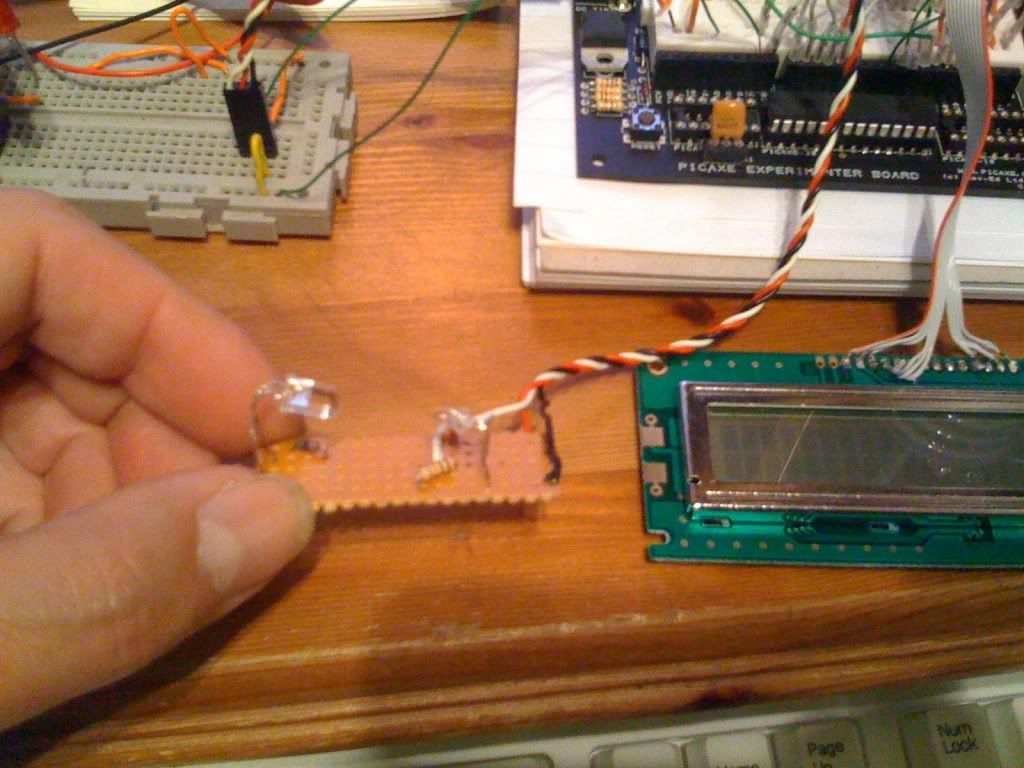Just about got the following into a useable state. This is my first Picaxe project and, truth be told, I'm still working on various things but thought someone might be interested in the work so far. I'd be grateful for any comments and also if someone could come up with a better name!
One of the reasons for using a Picaxe and stripboard design was to make the unit simple enough for other interested photographers, with a little electronics experience, to make a similar unit.
Description
The unit is used to trigger either a digital SLR camera or flash when a particular event occurs. There are four programs in the standard setup, these are:
The unit incorporates an external program download socket to enable updates and loading of new programs, a 16x2 character backlit LCD and 12 digit keypad.
Limitations...
Here are some links
Picture of the unit without the sensor or camera/flash leads.
Zip file of the code - too much to put up here easily.
The circuit diagram in two parts. Part one and part two.
The stripboard layout
One of the reasons for using a Picaxe and stripboard design was to make the unit simple enough for other interested photographers, with a little electronics experience, to make a similar unit.
Description
The unit is used to trigger either a digital SLR camera or flash when a particular event occurs. There are four programs in the standard setup, these are:
- Menu - Selects the program to run.
- High speed flash trigger - An IR LED/Phototransistor pair are used to detect the passage of an object such as a drop of water. On activation a delay is instituted and then the flash is fired capturing a photograph of the object hitting a target (normally a bowl of water). The above takes place in a darkened room with the camera shutter held open using the camera "Bulb" setting and a cable release.
- Interval timer - Allows a succession of photographs to be taken at a pre-determined interval. Up to 6000 photographs can be taken (depending on camera memory) at intervals ranging from 1 second to 24 hours. Photographs produced can then be combined into a time lapse video using Quicktime Pro or similar.
- Bulb Timer - Allows long open shutter photographs to be made without having to hold down a cable release button. Particularly useful for star trail photographs and low level IR photography.
The unit incorporates an external program download socket to enable updates and loading of new programs, a 16x2 character backlit LCD and 12 digit keypad.
Limitations...
- The unit does not work directly with some Canon flashes. This is a common issue with flash triggers and possible fixes are being investigated. The unit can still be used with Canon flashes but requires an external radio trigger.
- Timing for the Interval Timer and Bulb timer are achieved using the pause command and as such are only accurate to +-1%. Testing with the finished unit indicate a better accuracy than suggested but the unit should not be used for critical applications.
- Flashes with trigger voltages in excess of 400V should not be used.
- The delay for the High Speed Flash Trigger is adjustable in 10us steps but because of the processing overhead of the Picaxe chip there is an additional delay (yet to be measured) which would prevent the use of the unit with very fast moving objects such as bullets.
Here are some links
Picture of the unit without the sensor or camera/flash leads.
Zip file of the code - too much to put up here easily.
The circuit diagram in two parts. Part one and part two.
The stripboard layout


